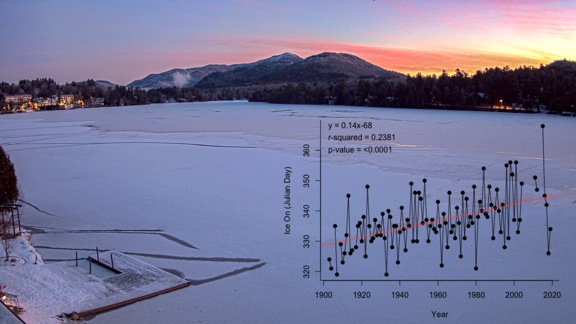AUSABLE WATER WISE: Records for Mirror Lake show shorter ice time

Ice records on Mirror Lake (Artwork provided by Ausable River Association)
Mirror Lake has the longest lake ice record in New York state, dating back to 1903.
Every year, a stalwart group of Mirror Lake aficionados engage in the art and science of guessing the timing of ice-in and ice-out. Ice-in refers to a full sheet of ice covering the lake. Ice-out is when the lake is completely ice free. The record has been referenced in several scientific papers, written about in books, and is frequently covered in the news and on social media. It also helps us understand change in Mirror Lake and in lakes across the country.
The most significant trend in the record is a shift toward later ice-in. Over the period of record, the lake now freezes, on average, 16 days later than it did in 1903. In 1903, the average ice-in date was Dec. 1, and today it is Dec. 17. Ice-out doesn’t show a statistically significant trend, but the lake has been shifting toward earlier ice-out since the 1970s. The net result of the shift in both ice-in and ice-out is that the lake is covered with ice 24 fewer days on average today than it was the turn of the 20th century.
What does that mean? Fewer days of ice cover mean fewer days of ice skating, pond hockey, and dog sled rides. On the other hand, it means more time to swim, kayak, and paddleboard on the lake. But the impact of this shift on the lake isn’t limited to our recreational use.
Lakes across the Northern Hemisphere are experiencing similar shifts in ice cover. One consequence is that these lakes are experiencing longer periods of thermal stratification, the condition where the surface of the lake is warm, but the bottom remains cold. In Mirror Lake, for example, this limits habitat for lake trout, as they struggle to find water that is both cool and well oxygenated. Oxygen in the deep water of a lake declines throughout the summer due to respiration from bacteria and other organisms. Another shift documented by scientists is a significant decrease in phytoplankton and zooplankton communities, the organisms that form the base of the aquatic foodweb. To the causal observer, such changes go unseen and unnoticed.
You might be wondering if the road salt in Mirror Lake is contributing to the reduction in ice cover. The salinity of Mirror Lake is 160 times higher than it should be, but still 1/200th that of sea water. The additional salt in Mirror Lake is enough to depress the freezing point of water by 0.01C. This delays lake freezing by minutes or hours, not days to weeks.
In 2017, the Ausable River Association partnered with Golden Arrow Lakeside Resort to install a camera overlooking the lake to maintain the ice record. Each minute of every day, all year long, the camera captures and archives a high-resolution image of the lake. We’re creating a visual record of lake ice and other changes occurring around the lake.
Writing down the date a lake froze in a diary may seem like an inconsequential act. But small acts of observing and recording the world around us sometimes turn out to be incredibly valuable. That is certainly the case with the ice record for Mirror Lake. It is not only teaching us about a lake we all care about, it’s helping us understand how climate change is impacting lakes across the world.
—
(Brendan Wiltse is the science and stewardship director for the Ausable River Association, based in Wilmington.)





